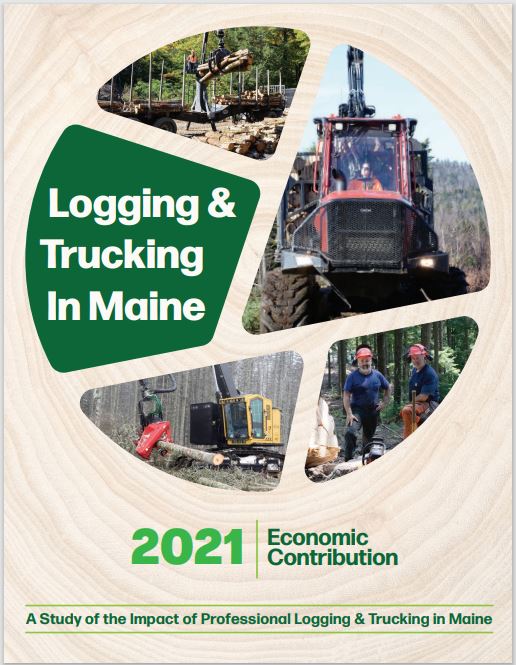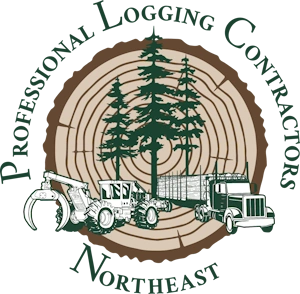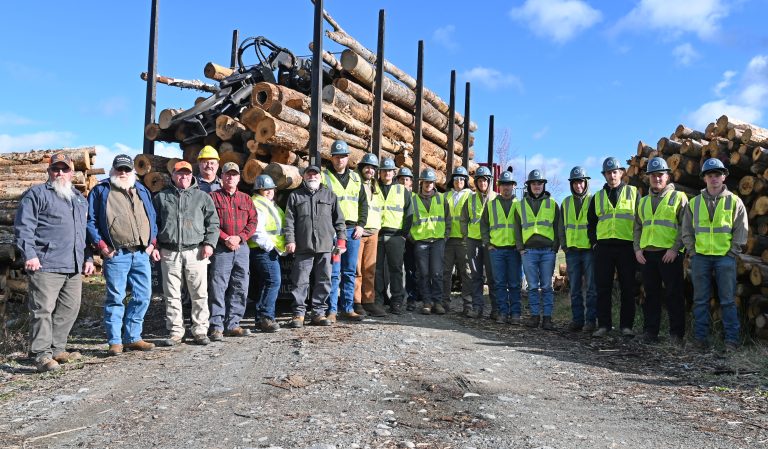Economic impact study reveals Maine loggers contributed an estimated $582 million to state economy in 2021
Study shows logging and woods trucking supports more than 5,600 jobs and a range of industries and communities in Maine
AUGUSTA – The Professional Logging Contractors (PLC) of Maine today released results of a comprehensive study of the economic impact of Maine logging and forest trucking, showing the industry contributed an estimated $582 million to the state economy in 2021.
The study, The Economic Contribution of Logging and Trucking in Maine, conducted by the University of Maine and the Margaret Chase Smith Policy Center, revealed that in 2021 logging supported approximately 5,600 Maine jobs either directly or indirectly, generated $312 million in labor income, pumped an estimated $27 million into state and local tax coffers, and remained critical to a range of industries and communities across Maine.
At the same time, the study showed the industry facing mounting challenges including rampant inflation, worker shortages, declining profits, market uncertainty, and erratic weather conditions.
“This study demonstrates the immense impact logging and forest trucking has on the Maine economy and highlights its importance as the foundation of the state’s entire $8.1 billion forest products industry,” Dana Doran, Executive Director of the Professional Logging Contractors of Maine, said. “It also shows an industry in crisis and reveals what Maine stands to lose if the challenges threatening logging are not overcome.”
Two similar studies have been conducted previously by the University of Maine, focusing on 2014 and 2017 data. The new study’s focus on 2021 data revealed the unique challenges faced by the industry at that point in time, as the aftermath of the loss of the Pixelle Specialty Solutions pulp digester at its Jay mill to an explosion in the spring of 2020 was felt and the COVID-19 pandemic rattled markets, supply chains, and the economy.
To better understand the nature of the harvesting industry in Maine, analysts combined a traditional input-output (IMPLAN) analysis with primary data gathered from member companies of the PLC, the logging trade association representing companies that together harvest more than 75 percent of all timber harvested in Maine. The study calculates the economic impact of logging in the state of Maine for 2021 through both the IMPLAN analysis as well as a survey delivered to members of the PLC. Data from the U.S. Bureau of Labor Statistics, the U.S. Census Bureau, and other appropriate sources was incorporated in the analysis to present a complete picture of the industry’s status.
In addition to the overall economic impact of logging and forest trucking, key findings of the study and associated research included:
∙ Average annual earnings in 2021 for workers in the industry were $65,000 per job. This represents a significant increase over the average found in 2017 of $47,289.
∙ In Maine the industry saw a 15% decline in the total number of jobs between 2014 and 2021, while jobs in the industry nationally dropped 9% over the same period.
∙ On average, survey respondents had 42 operational weeks in 2021 and harvested 1,403 acres per firm. Average operational weeks matched 2017, but acreage harvested dropped from 1,621 acres per firm in 2017.
∙ Mechanization remains dominant in the industry: Fully 55 percent of surveyed firms were identified as whole tree harvesting operations, and another 35 percent as cut-to-length harvesting operations – both of which use combinations of mechanized logging equipment such as feller bunchers, delimbers, grapple skidders, forwarders, and harvesters to cut, yard, and process wood. Only 10 percent were identified as conventional hand crews using chain saws.
∙ Most respondents trucked either all (37%) or a majority (14%) of the material harvested by their firm. Eight percent rarely (less than half the time) trucked their own material and 41% percent contracted with an outside source for all their trucking needs.
∙ Thirty-nine percent reported that their ability to harvest or sell wood has stayed the same over the last five years, while 33% reported it has decreased, and 28% reported it has increased.
∙ Respondents felt that inflation and business costs, mill closures, access to qualified labor, market price, timely access to repair parts, and weather are the most important factors affecting their ability to attain maximum production.
∙ When asked about inflation (change in their business costs between September 2020 and September 2022) 67% reported seeing an increase of between 21% and 40%. Sixteen percent reported seeing an increase of over 50%. The average increase was $35.74 percent.
∙ Sixty-three percent of firms reported engaging in activities in addition to logging services. The most frequently cited additional activity was road construction or maintenance.
∙ The majority of 2021 respondent employees worked in the woods, on average 6 per firm; an additional average of 1 employee per firm provided office support, 2 employees provided trucking support, and 1 provided mechanical support. It is notable that the average number of wood-based employees per firm, as calculated from survey responses, was half of what it was in 2014.
∙ Respondents reported $21.7 million in new capital investment – 78 percent of which was spent on new equipment.
∙ Twenty-two percent of respondents reported having a succession plan in place. Of those who reported having a plan, 75% revolved around having family take over the business.
“There are two important conclusions to be drawn from the results of this study, and the first is that logging is a critical Maine industry under threat that must be preserved if the state is to avoid a collapse of its entire forest products industry and the irreversible impacts that would have on Maine’s economy, rural communities, and character,” Doran said. “The second is that logging can be saved, but loggers and forest truckers must be paid more for the services they provide, and it can’t be turned on and off like a faucet if the forest products economy in Maine is going to be successful in the future. Loggers must be provided with a consistent operational environment with sustainable rates of pay to ensure that our youth see this industry as a viable career path.”
A brochure outlining and expanding on key findings of the study is available HERE.
Founded in 1995 with a handful of members who were concerned about the future of the industry, the PLC has grown steadily to become a statewide trade association which provides independent logging contractors a voice in the rapidly changing forest products industry. Board membership consists of only loggers, making it an organization that is run by loggers on behalf of loggers. PLC members are responsible for cutting 75 percent of the timber that is harvested from Maine’s forests annually.
Learn more about the PLC at www.maineloggers.com.


